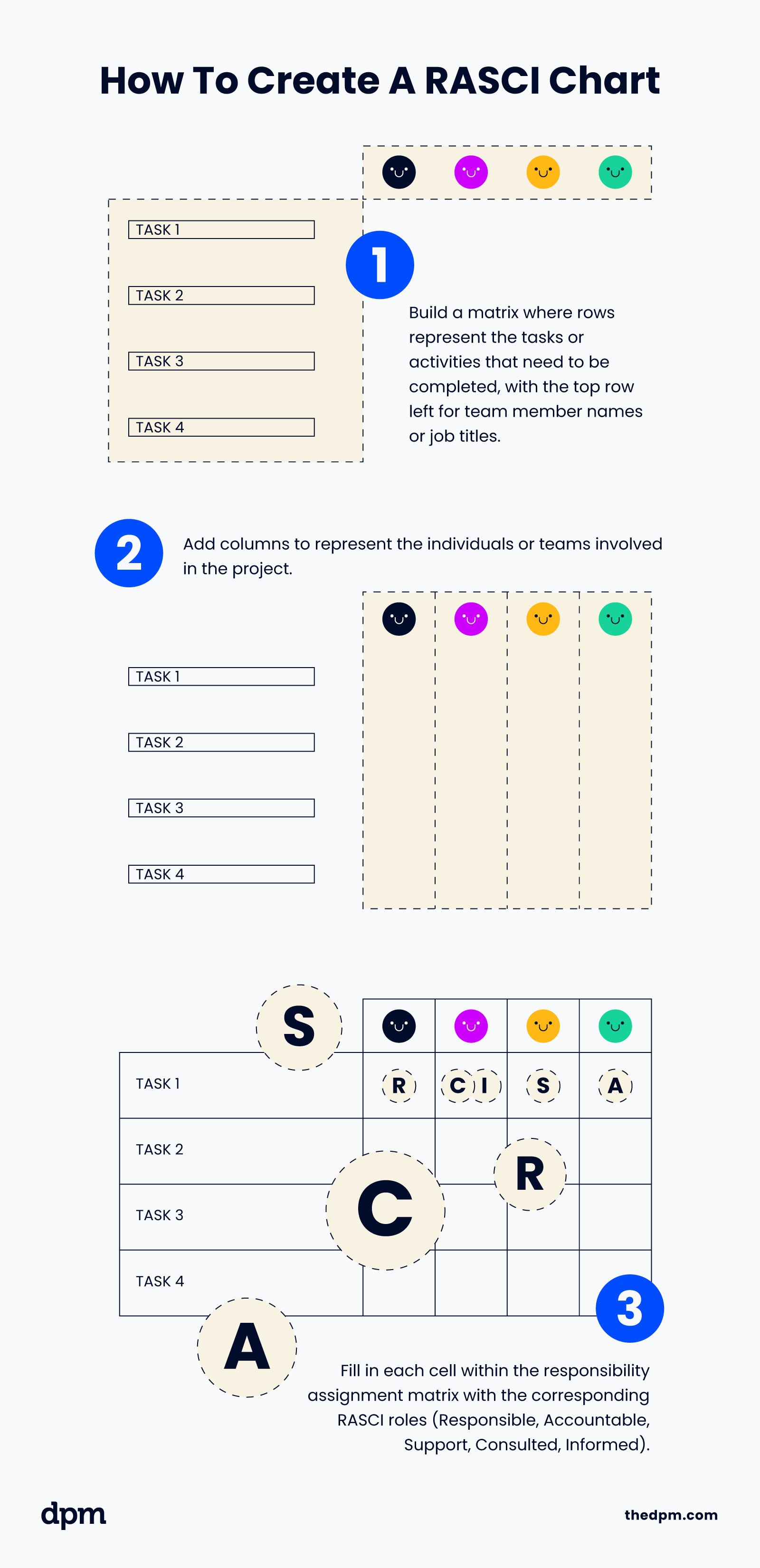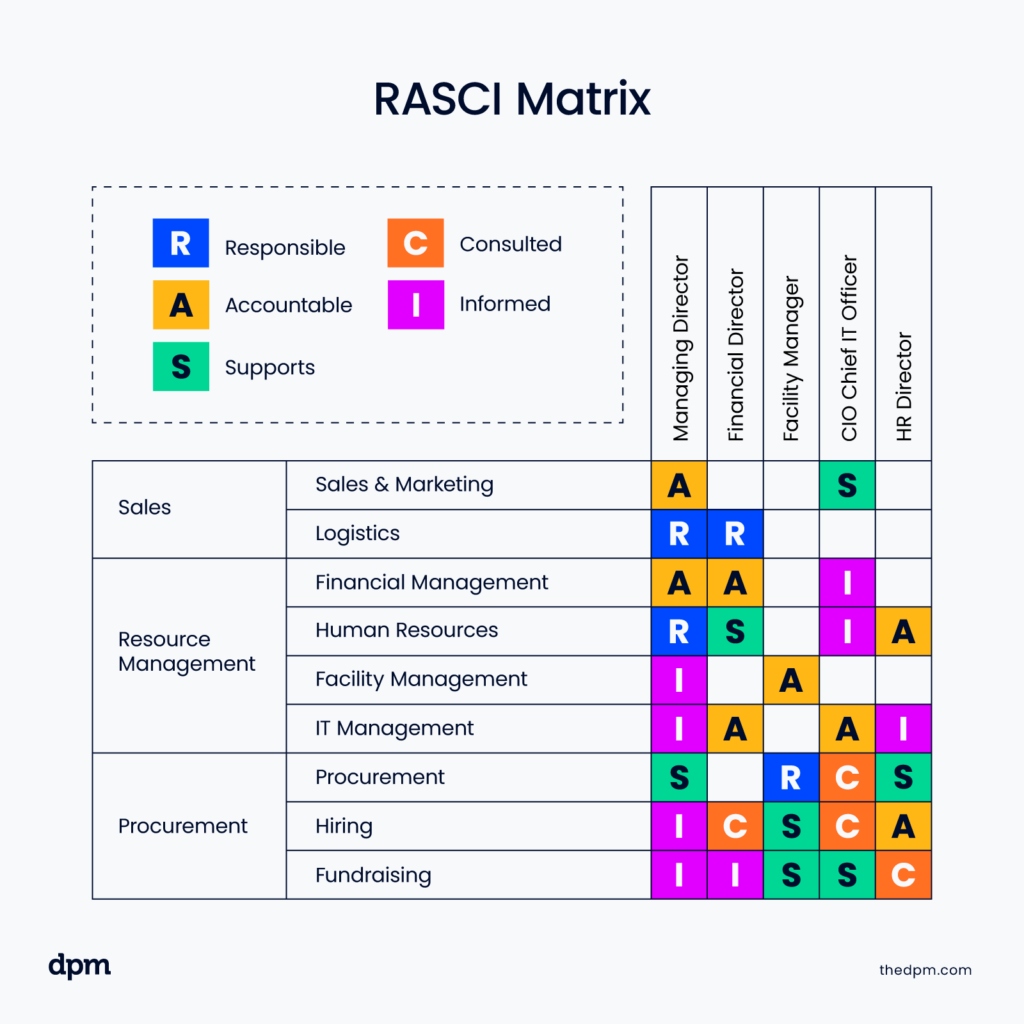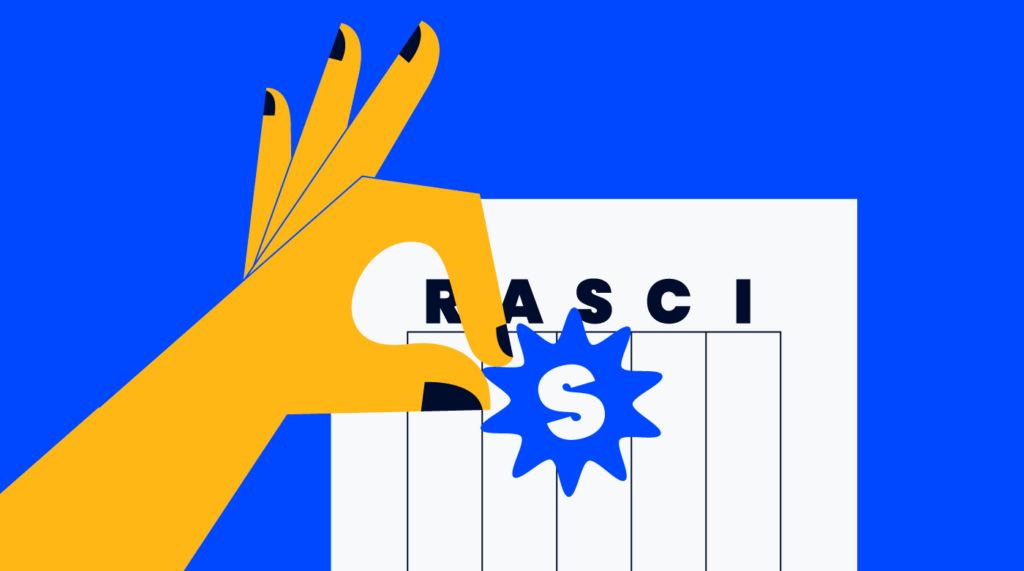The RASCI chart is an often-overlooked tool that's gaining momentum for its ability to streamline communication and collaboration, while eliminating confusion and bottlenecks. It’s useful no matter which methodology you’re following: agile, waterfall, Scrum, and others.
In this article, I'll take the guesswork out of the RASCI chart, explore its benefits, and highlight the key differences between RASCI and the more widely-known RACI charts.
Get ready to become a RASCI chart pro and feel confident in deciding which framework is best suited for your project management needs. Welcome to a new era of clarity and efficiency!
What Is A RASCI Chart?
A RASCI chart, at its core, is a visual representation of the RASCI framework. It's designed to clearly outline the roles and responsibilities of each project team member or stakeholder involved in a project.
By mapping out the relationships between different tasks and the people who are responsible for them, the RASCI chart enables better communication, collaboration, and efficiency across your organization.
Here’s how to create a RASCI chart:
- Build a matrix where rows represent the tasks or activities that need to be completed, with the top row left for team member names or job titles.
- Add columns to represent the individuals or teams involved in the project.
- Fill in each cell within the responsibility assignment matrix with the corresponding RASCI roles (Responsible, Accountable, Support, Consulted, Informed).

This provides an at-a-glance view of who's responsible for what and how each person is involved in the project.
And the best part of a RASCI chart? It can be used for projects of all sizes and complexities. It’s an indispensable tool for project managers looking to streamline their processes and keep everyone on the same page.
So, whether you're managing a small team or coordinating a large, multi-disciplinary project, a RASCI chart can be your secret weapon for achieving project management success.
What Does RASCI Stand For?
Understanding the RASCI acronym will help you better understand the role of each person within the RASCI matrix.
Here’s the breakdown:
Responsible
This is the person or team who is tasked with performing the work to complete a specific task, activity, or deliverable. The responsible person is driving the project forward and ensuring that milestones are met. It’s important to make this role clear so there is no pointing fingers after the fact.
Accountable
The accountable person holds ultimate ownership for a task's completion and outcome. They may not be responsible for the actual tasks getting done, but they are responsible for whether they are completed.
Typically, this is someone higher in the organizational hierarchy, like a project manager or team leader. The accountable person usually delegates tasks to the responsible role but answers to any questions on the overall success or failure of the project.
Support
Support roles are the workhorses, the behind-the-scenes heroes who provide assistance to the responsible role.
These individuals or teams use their skills, knowledge, or resources to help make sure the job gets done in the most efficient way. They do not hold any decision-making responsibility but are equally crucial to the project's success.
Consulted
In the RASCI framework, the consulted role represents subject matter experts or stakeholders whose input is needed for critical decisions or problem-solving.
Their opinions and advice are highly valued, but they do not carry the final decision-making authority. This role helps to ensure that important perspectives are considered and potential issues are addressed.
Think about when you are making your wedding guest list and your parents tell you that you need to clear the list with your grandparents to make sure you invited everyone you should have. Your grandparents are in the consulted role. Ultimately you’ll still decide who is invited but it’s important to consult with them so you don’t ruffle any feathers.
Informed
Last but not least, the informed role is for those who need to be kept in the loop about the progress or outcomes of a task, but are not directly involved in the execution.
This can include team members, stakeholders, or even clients who require updates to stay aligned with the project's direction. This is often a C-level stakeholder who has no direct role within the project, but can approve budget and timeline changes if needed.
Understanding the dynamics of each role within the RASCI matrix, from decision-maker to contributor, empowers you to optimize your project management approach, fostering a collaborative and transparent environment that leads to greater success.
What Are RASCI Charts Used For?
RASCI charts provide clarity on who's doing what in a project or decision-making process. This way, there's less chance of miscommunication or dropped balls, and everyone knows their role. They also help promote more efficient communication and collaboration throughout the entire project.
Here's how to create and use a RASCI chart:
- Identify the Tasks and Roles: Start by jotting down all the tasks that need to be done in your project. Next, figure out who will be involved—this could be individuals, whole teams, or even entire departments.
- Get that Matrix Going: Now, put together a matrix. Your tasks go down the rows, and the people or teams involved go across the top columns.
- Match them with RASCI Roles: For every task and team combo, you're going to assign a RASCI role—that's Responsible, Accountable, Support, Consulted, or Informed. This way, you get a clear picture of who's doing what for every task.
- Talk it Out: Share your shiny new RASCI chart with your team. Make sure everyone gets their role and is comfy with it. If there are any questions or worries, sort them out and tweak the chart if needed.
- Keep an Eye on Things: As your project moves forward, keep a close watch on your RASCI chart. It'll help you keep track of project progress and make sure everyone's sticking to their roles. If anything changes, just update the chart.
When you start using these RASCI charts, it's like magic for your project management. It really helps keep the conversation clear between everyone on the team and encourages folks to work together. The end result? Your project gets done smoother and more successfully.
RASCI Chart Example
It’s helpful to have a visual of a RASCI chart to see what I’m talking about. The example RASCI chart below breaks down the project roles assigned to the sales tasks, resource management tasks, and procurement tasks. Basic RASCI charts like these can be set up in Excel or Google Sheets.

6 Differences Between RACI and RASCI Charts
A RACI chart is a project management tool that maps out the roles and responsibilities of team members across a project's tasks, using four key RACI roles: Responsible, Accountable, Consulted, and Informed.
In contrast, a RASCI chart expands upon the RACI framework by adding another important role—Support—providing a more detailed and collaborative approach to managing projects and resources.
Let’s dive into the key differences between the RACI and RASCI charts, allowing you to determine which framework best suits your project management needs:
- The Support Role: The most obvious difference between the RACI model and RASCI is the addition of the Support (S) role in RASCI. This role acknowledges and highlights the people who provide assistance and resources to the Responsible role, which also helps create a more collaborative environment.
- Complexity: RASCI charts are typically more detailed and comprehensive than the RACI matrix because of the addition of the Support role. This added layer of complexity allows for a clearer understanding of the dependencies and relationships between team members.
- Team Collaboration: The RASCI model emphasizes teamwork and collaboration by calling out the Support role, which is the crux of collaboration. This focus on cooperation helps create a more unified and cohesive team, ultimately having a more positive impact on the overall success of a project.
- Resource Allocation: With the Support role in place, RASCI charts provide a better overview of resource allocation and allow project managers to optimize the use of resources and skill sets across the team. The more efficiently resources are used, the more effectively a team can manage a project and its success.
- Flexibility: While RACI charts work well for smaller projects or teams with clearly defined roles, RASCI charts offer more flexibility for larger or more complex projects that can include multiple teams, departments, or stakeholders. This is because they provide a more nuanced representation of the different roles and responsibilities.
- Decision-Making: RASCI charts tend to foster faster and more effective decision-making. This is because the Support role helps streamline the process by highlighting the right resources and expertise needed to resolve issues and get the balling rolling.
There are a variety of other variations of RACI that you might have heard of, like DACI, CARS, CLAM, and others.
7 Benefits Of RASCI Charts
RASCI charts are like a secret weapon for project managers and teams. Here are seven reasons why you're going to want to use RASCI charts in your projects:
- Increased Clarity: RASCI charts help everyone see what they need to do on the project, making sure we're all singing from the same song sheet, heading towards the same goal.
- Improved Efficiency: With a RASCI chart, everyone knows their role, so tasks get done quicker and workflows are smoother. It's all about making the best use of your team's time and skills.
- Enhanced Collaboration: The Support role in RASCI encourages everyone to chip in and help each other out, making for a more collaborative and successful project.
- Better Decision-Making: RASCI charts help you pull in the right people with the right know-how for each particular task. This means decisions are well-informed and based on expert advice.
- Reduced Risk: RASCI charts help catch potential issues early on, so you can dodge those pesky project potholes. It's all about being proactive and reducing the risk of surprises.
- Greater Accountability: RASCI charts are great for keeping everyone accountable for their tasks. It's like a friendly reminder that we all need to pull our weight to get the project across the finish line.
- Scalability: The beauty of RASCI charts is that they can be tweaked to fit any project, big or small, simple or complex. It's like a Swiss Army Knife for your project management needs.
Unlock the Power of RASCI Charts
RASCI charts are a real game-changer for managing projects. They're like a GPS, guiding your project to clarity, efficiency, and awesome teamwork. Knowing how RACI and RASCI charts differ, and using the perks of RASCI to your advantage, can really boost your project management game.
So, next time you kick off a project, give RASCI charts a try. They might just be the secret sauce to help your team soar and take your projects to a whole new level.
Subscribe to the Digital Project Manager newsletter today and stay up-to-date with the latest industry trends, strategies, and best practices that will help you become a more effective and confident project manager.

